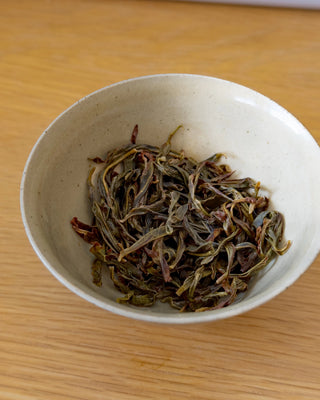
-
A clear super premium character of Ginkgo (銀杏) is revealed in this competition tea, and we finally uncover the truth behind the Chinese saying Xing Hua Xiang (apricot flower) or Xing Ren Xiang (almond).
Apricot is more fruity and sweet, while Almond has a baked, nutty and woody base. Ginkgo, on the other hand, represents a whole distinct level of description for this typical fragrance among the Ten Main Types of Fragrance in Feng Huang (Phoenix) Dancong.
It is a mix of Apricot flower in the front and a very long-lasting and rising aroma of Ginkgo in the base.
The aroma is intense, not like a plash at the front of the nose, but melodiously rising at the back of the nosal, and then it penetrates the body vertically.
On the lid of the Gaiwan, it has a clean aroma of the peel of a yellow pear (mainly in China, Korea, with crisp texture and refreshing cane-sugar sweetness) and ginkgo seed, and the sweetness is slowly rising from your second or third inhale (when it has cooled down a bit).
The texture is silky, and the aroma is cocooned in the tea soup; it unfolds in the mouth and flows from your mouth into your throat. Hui Gan (回甘) is obvious; I feel like I'm still tasting the tea in my mouth, but I actually drank it minutes ago.
The aroma remains stable and consistent for seven brews in Gong Fu Cha brewing. And the it start turning a bit into milky, creamy and sugary sensation.
A clear super premium character of Ginkgo (銀杏) is revealed in this competition tea, and we finally uncover the truth behind the Chinese saying Xing Hua Xiang (apricot flower) or Xing Ren Xiang (almond).
Apricot is more fruity and sweet, while Almond has a baked, nutty and woody base. Ginkgo, on the other hand, represents a whole distinct level of description for this typical fragrance among the Ten Main Types of Fragrance in Feng Huang (Phoenix) Dancong.
It is a mix of Apricot flower in the front and a very long-lasting and rising aroma of Ginkgo in the base.
The aroma is intense, not like a plash at the front of the nose, but melodiously rising at the back of the nosal, and then it penetrates the body vertically.
On the lid of the Gaiwan, it has a clean aroma of the peel of a yellow pear (mainly in China, Korea, with crisp texture and refreshing cane-sugar sweetness) and ginkgo seed, and the sweetness is slowly rising from your second or third inhale (when it has cooled down a bit).
The texture is silky, and the aroma is cocooned in the tea soup; it unfolds in the mouth and flows from your mouth into your throat. Hui Gan (回甘) is obvious; I feel like I'm still tasting the tea in my mouth, but I actually drank it minutes ago.
The aroma remains stable and consistent for seven brews in Gong Fu Cha brewing. And the it start turning a bit into milky, creamy and sugary sensation.


